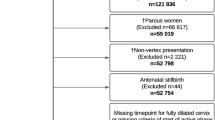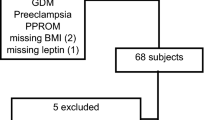Abstract
Objective:
There is controversy as to whether maternal body mass index (BMI) influences the contractility of human myometrium in pregnancy. The aim of this study was to examine spontaneous contractile activity of human pregnant myometrium in vitro, with respect to maternal BMI.
Study Design:
Myometrial tissue specimens were obtained at cesarean delivery from 74 women with BMI values ranging from 19 to 50.1 kg m–2. By recording in vitro from eight strips per donor (590 strips in total), several parameters of spontaneous contractile activity were monitored. The relationship between BMI and contractility was evaluated using linear regression analysis.
Results:
There was a significant correlation between maximum amplitude (P=0.007) and mean contractile force (P=0.001) with increasing BMI. However, the time to onset of contractions (P=0.009), and time taken to reach maximal amplitude (P=0.020) also increased with increasing BMI. No significant correlation was observed with BMI for other parameters studied. The mean maximum amplitude value for spontaneous contractions was 37±1 mN, the mean contractile force for spontaneous contractions was 4.1±0.1 mN, the average time to the first spontaneous contraction was 11.3±0.6 min and the average frequency of contractions was 6.5±0.2 per hour.
Conclusions:
These results suggest that the time to onset of contractions is increased with increasing maternal BMI, but that the force developed is greater. In all other respects, human uterine contractility is unaffected by increasing BMI. These findings underline the complexity of regulation of uterine contractility in labor with elevated maternal BMI.
This is a preview of subscription content, access via your institution
Access options
Subscribe to this journal
Receive 12 print issues and online access
$259.00 per year
only $21.58 per issue
Buy this article
- Purchase on Springer Link
- Instant access to full article PDF
Prices may be subject to local taxes which are calculated during checkout



Similar content being viewed by others
References
Barau G, Robillard PY, Hulsey TC, Dedecker F, Laffite A, Gérardin P et al. Linear association between maternal pre-pregnancy body mass index and risk of caesarean section in term deliveries. Br J Obstet Gynecol 2006; 113 (10): 1173–1177.
Lynch CM, Sexton DJ, Hession M, Morrison JJ . Obesity and mode of delivery in primigravid and multigravid women. Am J Perinatol 2008; 25 (3): 163–167.
Sebire NJ, Jolly M, Harris JP, Wadsworth J, Joffe M, Beard RW et al. Maternal obesity and pregnancy outcome: a study of 287,213 pregnancies in London. Int J Obes Relat Metab Disord 2001; 25 (8): 1175–1182.
Dzakpasu S, Fahey J, Kirby RS, Tough SC, Chalmers B, Heaman MI et al. Contribution of prepregnancy body mass index and gestational weight gain to adverse neonatal outcomes: population attributable fractions for Canada. BMC Pregnancy Childbirth 2015; 15: 21.
Li N, Liu E, Guo J, Pan L, Li B, Wang P et al. Maternal prepregnancy body mass index and gestational weight gain on pregnancy outcomes. PLoS One 2013; 8 (12): e82310.
Lamminpää R, Vehviläinen-Julkunen K, Gissler M, Selander T, Heinonen S . Pregnancy outcomes of overweight and obese women aged 35 years or older - a registry-based study in Finland. Obes Res Clin Pract 2015; 10 (2): 133–142.
Graves BW, DeJoy SA, Heath A, Pekow P . Maternal body mass index, delivery route, and induction of labor in a midwifery caseload. J Midwifery Womens Health 2006; 51 (4): 254–259.
Fyfe EM, Anderson NH, North RA, Chan EH, Taylor RS, Dekker GA et al. Risk of first-stage and second-stage cesarean delivery by maternal body mass index among nulliparous women in labor at term. Obstet Gynecol 2011; 117 (6): 1315–1322.
Zhang J, Bricker L, Wray S, Quenby S . Poor uterine contractility in obese women. Br J Obstet Gynecol 2007; 114 (3): 343–348.
Parkington HC, Stevenson J, Tonta MA, Paul J, Butler T, Maiti K et al. Diminished hERG K+ channel activity facilitates strong human labour contractions but is dysregulated in obese women. Nat Commun 2014; 5: 4108.
Higgins CA, Martin W, Anderson L, Blanks AM, Norman JE, McConnachie A et al. Maternal obesity and its relationship with spontaneous and oxytocin-induced contractility of human myometrium in vitro. Reprod Sci 2009; 17 (2): 177–185.
Sweeney EM, Crankshaw DJ, O'Brien Y, Dockery P, Morrison JJ . Stereology of human myometrium in pregnancy: influence of maternal body mass index and age. Am J Obstet Gynecol 2013; 208 (4): 324.e1–324.e6.
Grotegut CA, Gunatilake RP, Feng L, Heine RP, Murtha AP . The influence of maternal body mass index on myometrial oxytocin receptor expression in pregnancy. Reprod Sci 2013; 20 (12): 1471–1477.
Crankshaw DJ, O'Brien YM, Crosby DA, Morrison JJ . Maternal age and contractility of human myometrium in pregnancy. Reprod Sci 2015; 22 (10): 1229–1235.
Crankshaw DJ, Walsh JM, Morrison JJ . The effects of methyl palmitate, a putative regulator from perivascular fat, on the contractility of pregnant human myometrium. Life Sci 2014; 116: 25–30.
Crankshaw DJ, Morrison JJ . Methodology and pharmacological analysis of effects of uterotonic compounds in human myometrium in vitro. Am J Obstet Gynecol 2011; 205 (2): 155.e1–155.e6.
Crankshaw DJ, Sweeney EM, O'Brien YM, Walsh JM, Dockery P, Morrison JJ . The influence of smooth muscle content and orientation in dissected human pregnant myometrial strips on contractility measurements. Eur J Pharmacol 2014; 738: 245–249.
Denison FC, Price J, Graham C, Wild S, Liston WA . Maternal obesity, length of gestation, risk of postdates pregnancy and spontaneous onset of labour at term. Br J Obstet Gynecol 2008; 115 (6): 720–725.
Cedergren MI . Non-elective caesarean delivery due to ineffective uterine contractility or due to obstructed labour in relation to maternal body mass index. Eur J Obstet Gynecol Reprod Biol 2009; 145 (2): 163–166.
Ferreira CJ, Odendaal HJ . Does coupling of uterine contractions reflect uterine dysfunction? S Afr Med J 1994; 84 (1): 20–23.
Luckas MJ, Wray S . A comparison of the contractile properties of human myometrium obtained from the upper and lower uterine segments. Br J Obstet Gynecol 2000; 107 (10): 1309–1311.
Smith GCS, Cordeaux Y, White IR, Pasupathy D, Missfelder-Lobos H, Pell JP et al. The effect of delaying childbirth on primary cesarean section rates. PLoS Med 2008; 5 (7): e144.
Arrowsmith S, Robinson H, Noble K, Wray S . What do we know about what happens to myometrial function as women age? J Muscle Res Cell Motil 2012; 33 (3-4): 209–217.
Moynihan AT, Hehir MP, Glavey SV, Smith TJ, Morrison JJ . Inhibitory effect of leptin on human uterine contractility in vitro. Am J Obstet Gynecol 2006; 195 (2): 504–509.
Hehir MP, Glavey SV, Morrison JJ . Uterorelaxant effect of ghrelin on human myometrial contractility. Am J Obstet Gynecol 2008; 198 (3): 323–325.
Lynch FM, Withers SB, Yao Z, Werner ME, Edwards G, Weston AH et al. Perivascular adipose tissue-derived adiponectin activates BK(Ca) channels to induce anticontractile responses. Am J Physiol Heart Circ Physiol 2013; 304 (6): H786–H795.
Hollowell J, Pillas D, Rowe R, Linsell L, Knight M, Brocklehurst P . The impact of maternal obesity on intrapartum outcomes in otherwise low risk women: secondary analysis of the birthplace national prospective cohort study. Br J Obstet Gynecol 2014; 121 (3): 343–355.
Acknowledgements
We are grateful to the theater staff at Galway University Hospital for their cooperation in the biopsy collection procedure. The work reported here was supported by the Galway University Hospital Perinatal Fund.
Author information
Authors and Affiliations
Corresponding author
Ethics declarations
Competing interests
The authors declare no conflict of interest.
Rights and permissions
About this article
Cite this article
Crankshaw, D., O'Brien, Y., Crosby, D. et al. Maternal body mass index and spontaneous contractility of human myometrium in pregnancy. J Perinatol 37, 492–497 (2017). https://doi.org/10.1038/jp.2016.271
Received:
Revised:
Accepted:
Published:
Issue Date:
DOI: https://doi.org/10.1038/jp.2016.271
This article is cited by
-
The Pathophysiology of Labor Dystocia: Theme with Variations
Reproductive Sciences (2023)
-
Forces Involved with Labor and Delivery—A Biomechanical Perspective
Annals of Biomedical Engineering (2021)
-
The effect of morbid obesity or advanced maternal age on oxytocin-induced myometrial contractions: an in vitro study
Canadian Journal of Anesthesia/Journal canadien d'anesthésie (2020)
-
Maternal parity and functional contractility of human myometrium in vitro in the third trimester of pregnancy
Journal of Perinatology (2019)



